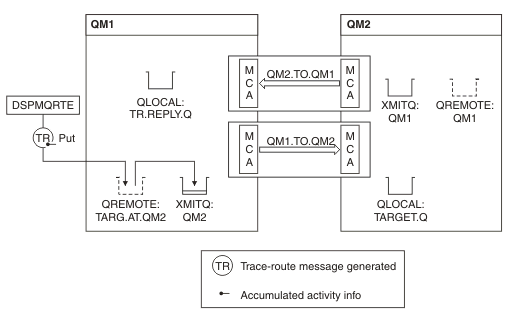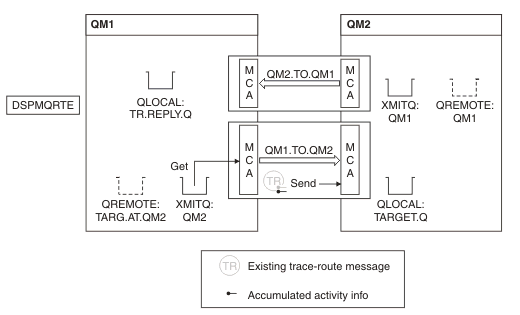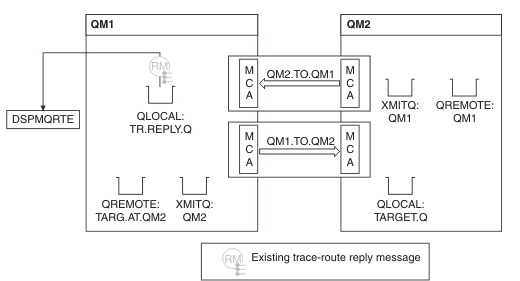Example 2 - Requesting a trace-route reply message
Generate and deliver a trace-route message to the target queue
In this example the IBM MQ display route application connects to queue manager, QM1, and is used to generate and deliver a trace-route message to the target queue, TARGET.Q, on remote queue manager, QM2. The necessary option is specified so that activity information is accumulated in the trace-route message. On arrival at the target queue a trace-route reply message is requested, and the trace-route message is discarded.
- The ROUTEREC attribute of each queue manager (QM1 and QM2) is set to MSG.
- The following command is issued:
dspmqrte -m QM1 -q TARG.AT.QM2 -rq TR.REPLY.Q -ac -ar -ro discard
QM1 is the name of the queue manager to which the IBM MQ display route application connects, TARG.AT.QM2 is the name of the target queue, and ACTIV.REPLY.Q is the name of the queue to which it is requested that all responses to the trace-route message are sent. The -ac option specifies that activity information is accumulated in the trace-route message, the -ar option specifies that all accumulated activity is sent to the reply-to queue that is specified by the -rq option (that is, TR.REPLY.Q). The -ro option specifies that report option MQRO_DISCARD_MSG is set which means that activity reports are not generated in this example. - DSPMQRTE accumulates activity information in the trace-route message before the message is put on the target route. The queue manager attribute ROUTEREC must not be DISABLED for this to happen.

- The message is a trace-route message, therefore the sending MCA begins to record information about the activity.
- The queue manager attribute ROUTEREC on QM1 is not DISABLED, therefore the MCA accumulates the activity information within the message, before the message is forwarded to queue manager QM2.

- The message is a trace-route message, therefore the receiving MCA begins to record information about the activity.
- The queue manager attribute ROUTEREC on QM2 is not DISABLED, therefore the MCA accumulates the information within the message.
- The target queue is a local queue, therefore the message is discarded with feedback MQFB_NOT_DELIVERED, in accordance with the Deliver parameter value in the TraceRoute PCF group.
- This is the last activity that will take place on the message, and because the queue manager attribute ROUTEREC on QM1 is not DISABLED, the MCA generates a trace-route reply message in accordance with the Accumulate value. The value of ROUTEREC is MSG, therefore the reply message is put on the reply queue. The reply message contains all the accumulated activity information from the trace-route message.

- Meanwhile DSPMQRTE is waiting for the trace-route reply message to return to the reply queue. When it returns, DSPMQRTE parses each activity that it contains and prints it out. The final operation is a discard operation. DSPMQRTE ends after it has been printed.
The output that is displayed follows:
AMQ8653: DSPMQRTE command started with options '-m QM1 -q TARG.AT.QM2 -rq TR.REPLY.Q'. AMQ8659: DSPMQRTE command successfully put a message on queue 'QM2', queue manager 'QM1'. AMQ8674: DSPMQRTE command is now waiting for information to display. AMQ8666: Queue 'QM2' on queue manager 'QM1'. AMQ8666: Queue 'TARGET.Q' on queue manager 'QM2'. AMQ8652: DSPMQRTE command has finished.Parent topic: IBM MQ display route application examples